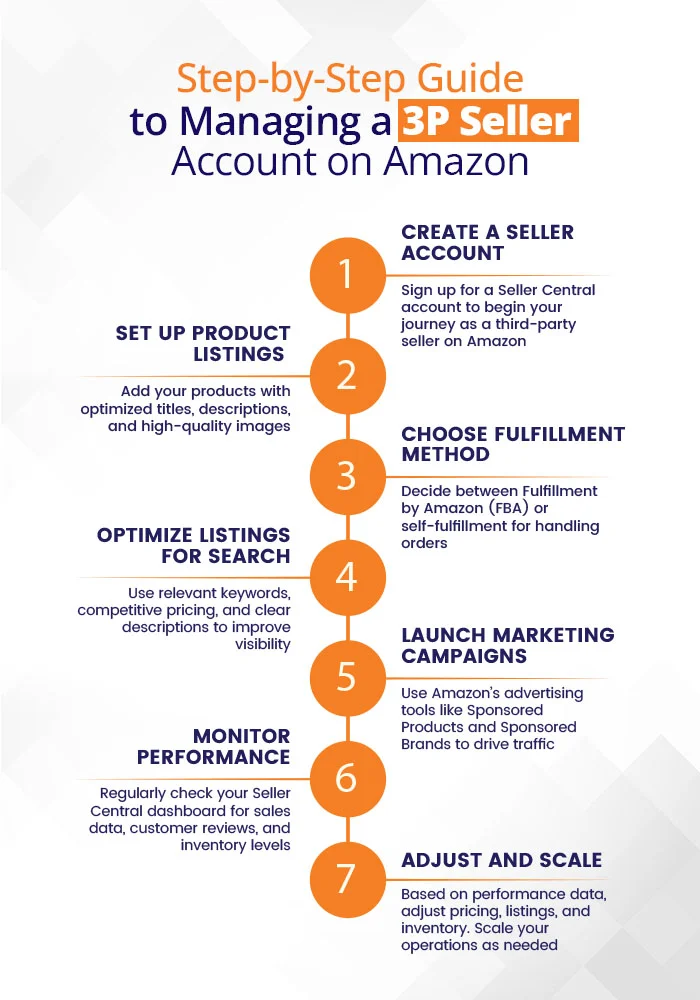Have you ever felt frustrated with not being able to control your Amazon pricing or brand image? As an Amazon seller, the constant challenge of balancing control with maximizing profits is all too familiar.
The decision between selling first-party (1P) or third-party (3P) on Amazon can significantly impact your business’s success. But which option gives you the control and flexibility to thrive?
In this blog, we’ll focus on the benefits of the 3P model, exploring why it’s becoming the go-to choice for sellers in 2024 and how you can leverage it to grow your brand effectively.
Understanding Amazon 1P vs 3P: Which Fits Your Brand?
Breaking Down the Basics
Amazon 1P: If you’ve been selling on Amazon as a first-party seller, you know that this model involves selling your products directly to Amazon at wholesale prices. Amazon then takes over, handling pricing, customer service, and even branding. While this might seem convenient, it also means giving up a significant amount of control over how your brand is presented and what profit margins you can achieve.
Amazon 3P: On the other hand, as a third-party seller, you sell directly to consumers on Amazon. This model, managed through Seller Central, allows you to maintain control over your pricing, inventory, and brand image. You can choose to fulfill orders yourself or use Fulfillment by Amazon (FBA) to handle logistics, making it a versatile option that fits various business models.
| Aspect | Amazon 1P | Amazon 3P |
| Control |
|
|
| Profit Margins |
|
|
| Inventory Ownership |
|
|
| Scalability |
|
|
| Branding |
|
|
| Customer Data |
|
|
| Fulfillment Options |
|
|
Why 3P Selling Gives You the Edge
Imagine having the ability to adjust your prices in real-time based on market trends or directly engage with your customers to build brand loyalty. This level of control is what makes 3P selling so powerful.
Control Over Pricing: Unlike 1P sellers, who are at the mercy of Amazon’s pricing strategy, 3P sellers can set prices that reflect the value of their products. This flexibility allows you to maximize profits, especially during peak sales seasons.
Brand Autonomy: You’re not just another product on the shelf; you’re building a brand. As a 3P seller, you have the freedom to craft your product listings, showcase high-quality images, and tell your brand’s story. This is essential for standing out in a crowded marketplace.
Higher Profit Margins: Selling directly to consumers means you’re not locked into wholesale pricing. This results in better margins, which can be reinvested into growing your business, whether it’s through new product development or enhanced marketing efforts.
Scalability with FBA: FBA takes the hassle out of logistics, allowing you to scale your business without the headache of managing warehousing or shipping. You can focus on what you do best—building your brand.
How to Succeed as a 3P Seller
Now that you understand why the 3P model is so advantageous, let’s dive into how you can make the most of it.
Setting Up for Success on Seller Central
Starting with Seller Central is your first step. This platform is where you’ll manage everything from listings to order processing. It’s crucial to familiarize yourself with its features and capabilities to streamline your operations.

Tip: Start small if you’re new to 3P selling. Focus on optimizing a few key products before expanding your range. This approach allows you to refine your processes and ensure you’re maximizing your return on investment.
Leveraging FBA to Streamline Operations
Fulfillment by Amazon (FBA) can be a game-changer, especially if you’re looking to scale quickly. By outsourcing logistics, you can reduce operational headaches and take advantage of Amazon’s vast distribution network.
Tip: Be strategic about what products you send to FBA. Consider factors like size, weight, and sales velocity to determine which items will benefit most from FBA’s efficiencies.
Optimizing Product Listings for Visibility
Your product listings are your storefront on Amazon. They need to be compelling, informative, and optimized for Amazon’s search algorithm.
Tip: Use high-quality images, clear and concise bullet points, and relevant keywords to improve your listings’ visibility and conversion rates. Enhanced Brand Content (EBC) or A+ Content can also help differentiate your products and tell your brand’s story more effectively.
Driving Sales with Effective Marketing
Marketing is key to driving traffic to your listings. Consider using Amazon’s advertising options, like Sponsored Products and Sponsored Brands, to boost visibility.
Tip: Don’t rely solely on Amazon’s internal traffic. Use social media, email marketing, and even influencer partnerships to drive external traffic to your Amazon store. This multi-channel approach can significantly increase your sales.
Potential Challenges of 3P Selling and How to Overcome Them
1. Challenge: High Competition
With millions of third-party sellers on Amazon, standing out in a crowded marketplace is a significant challenge. The competition is fierce, and it can be difficult to attract and retain customers, especially when other sellers offer similar products at competitive prices.
Solution:
- Optimize Product Listings: Invest in high-quality images, detailed descriptions, and relevant keywords to improve your product’s visibility in search results. Using tools like Jungle Scout or Helium 10 can help identify the most effective keywords and optimize your listings accordingly.
- Differentiate Your Brand: Focus on building a strong brand identity that resonates with your target audience. Utilize Amazon Brand Registry to protect your brand and access tools like A+ Content, which allows you to enhance your product descriptions with rich media.
- Leverage Amazon Advertising: Use Sponsored Products and Sponsored Brands to increase your product’s visibility. Target specific keywords and demographics to reach your ideal customers and stand out from the competition.
2. Challenge: Inventory Management and Fulfillment
Managing inventory effectively is crucial for 3P sellers. Overstocking can tie up capital and lead to increased storage fees, while understocking can result in missed sales and a negative impact on your Amazon ranking.
Solution:
- Use Inventory Management Tools: Implement inventory management software that integrates with Amazon Seller Central. These tools can help you track stock levels in real-time, set up automated reorder points, and forecast demand based on historical sales data.
- Diversify Fulfillment Methods: Consider using a combination of Fulfillment by Amazon (FBA) and Merchant Fulfilled Network (MFN) to manage your inventory more effectively. FBA can handle the bulk of your fulfillment needs, while MFN allows you to fulfill orders yourself when it makes sense financially or logistically.
- Monitor and Adjust: Regularly review your inventory performance metrics and adjust your strategy as needed. This may involve increasing your stock during peak seasons or reducing it during slower periods to optimize storage costs and cash flow.
3. Challenge: Maintaining Positive Customer Reviews
Customer reviews play a crucial role in influencing purchase decisions on Amazon. Negative reviews or a lack of reviews can hurt your product’s visibility and sales performance.
Solution:
- Provide Exceptional Customer Service: Respond to customer inquiries and issues promptly and professionally. Offering excellent customer service can help prevent negative reviews and encourage positive feedback.
- Encourage Reviews: After a successful purchase, politely request customers to leave a review. You can do this through follow-up emails or by including a request in the product packaging. Be sure to comply with Amazon’s guidelines on soliciting reviews to avoid penalties.
- Address Negative Reviews: If you receive negative feedback, address it promptly and professionally. Reach out to the customer to resolve the issue and, if possible, ask them to update their review once the issue has been resolved. Monitoring your reviews regularly can help you stay on top of potential problems and maintain a positive brand image.
Conclusion: Is 3P Selling Right for You?
For many sellers, the 3P model offers the flexibility, control, and profit potential needed to thrive on Amazon. Whether you’re just starting out or looking to switch from 1P to 3P, the key is to understand your brand’s unique needs and how the 3P model can meet them.
By focusing on optimizing your operations, leveraging FBA, and effectively marketing your products, you can position your brand for success in 2024 and beyond. For expert guidance on navigating the complexities of 3P selling, consider partnering with Prime Retail Solution, a leader in e-commerce growth and Amazon services.




